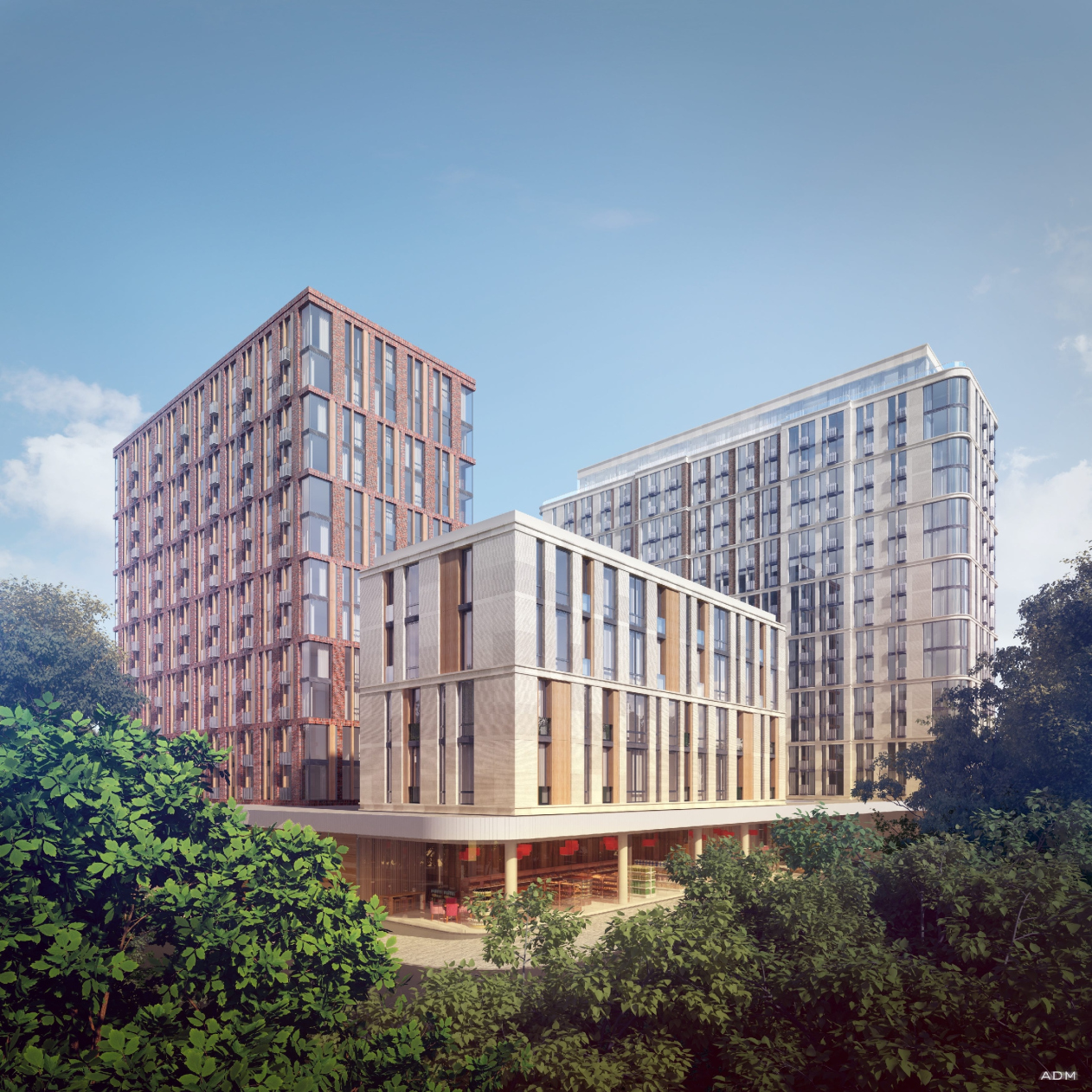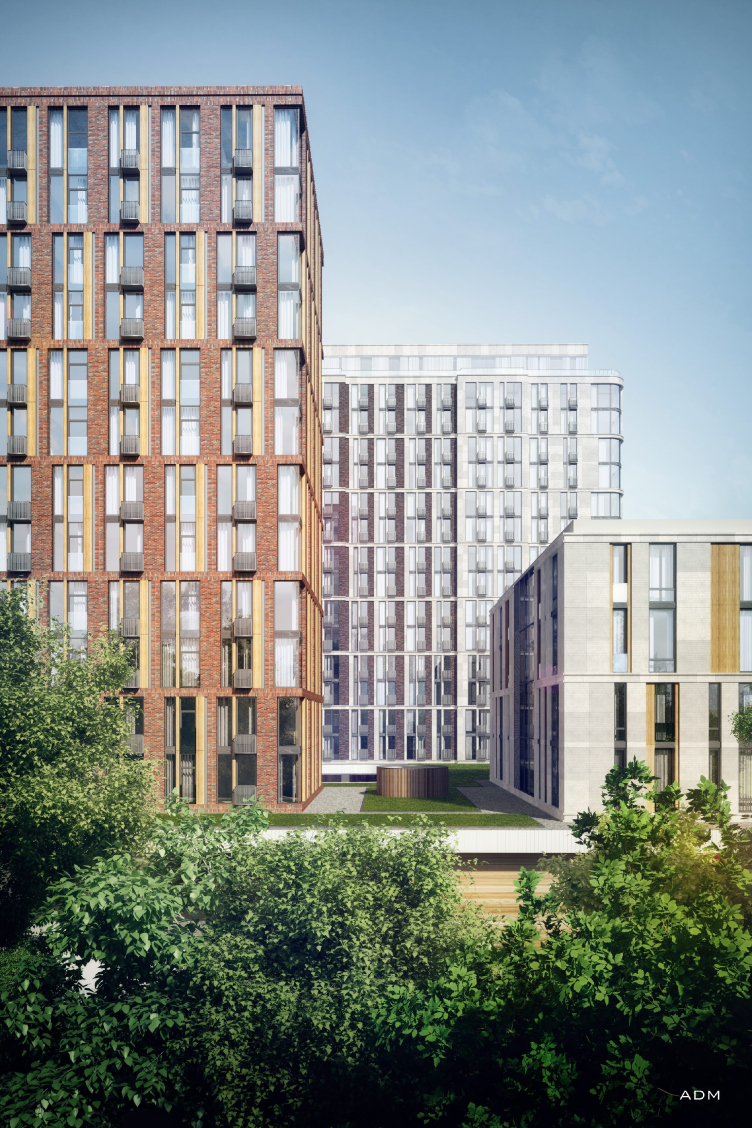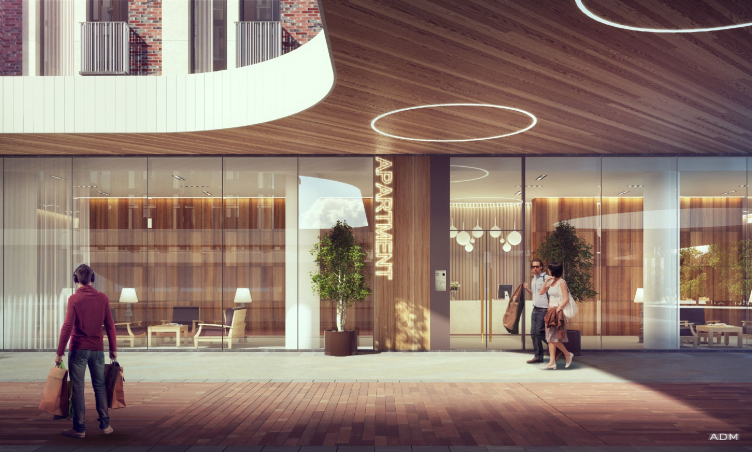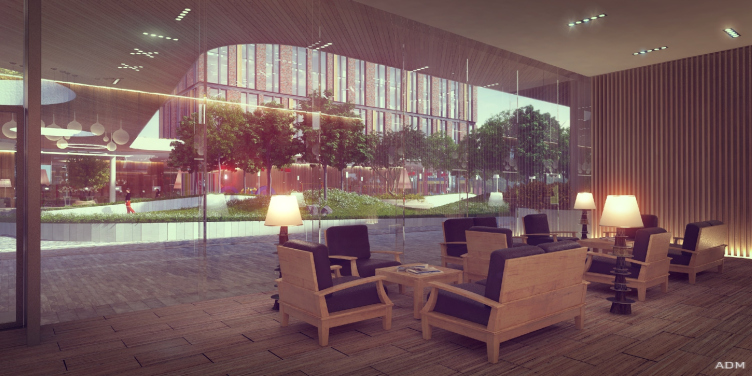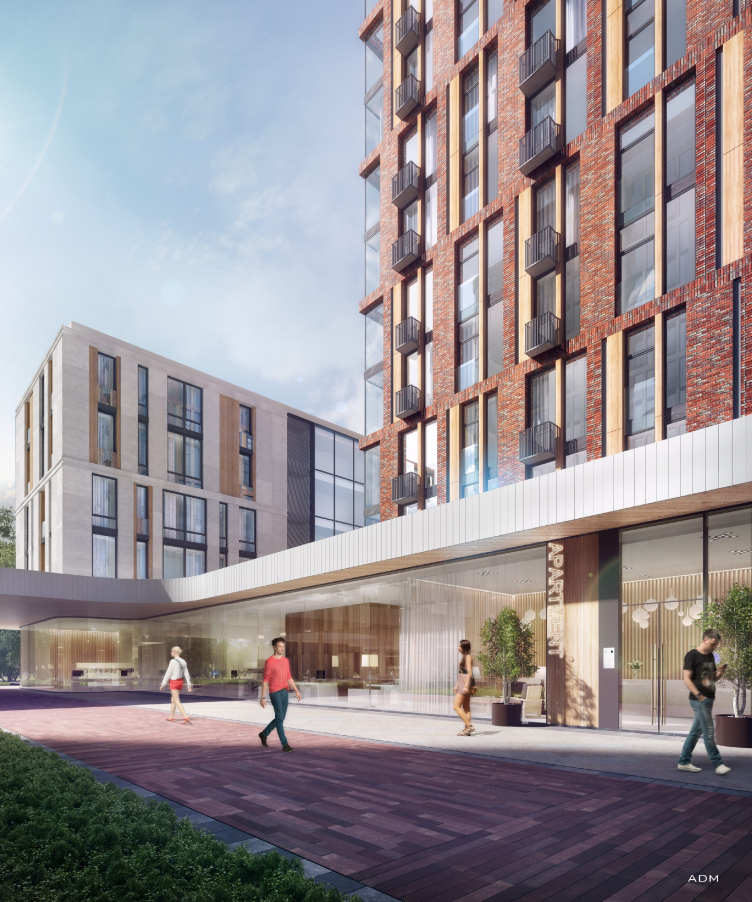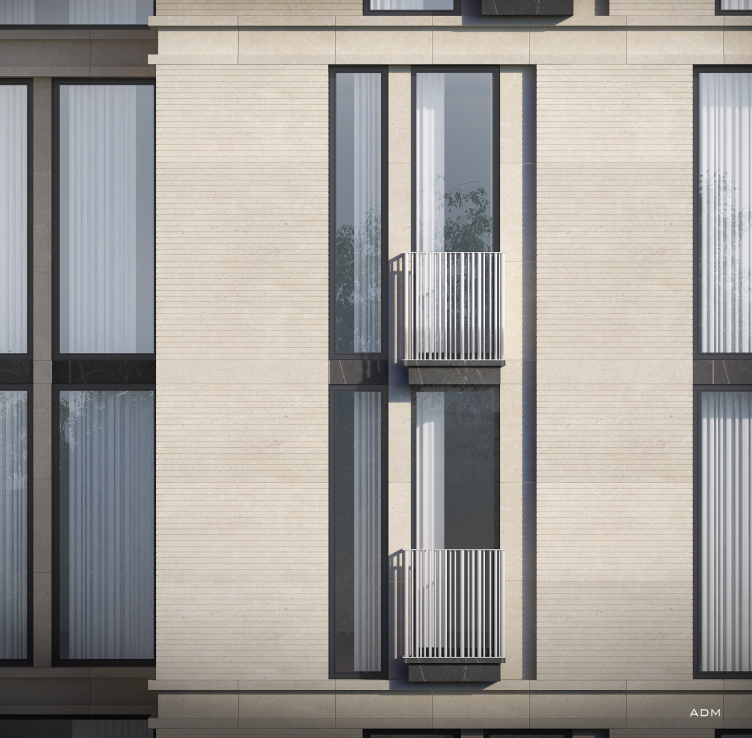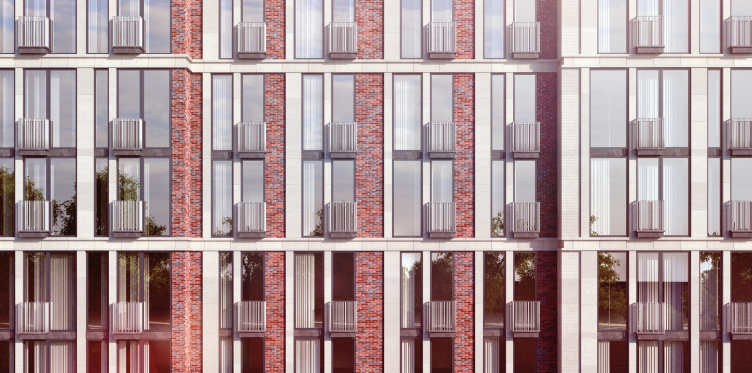In one of Moscow's most green districts, near Sparrow Hills, behind the dense screen of trees that fence off this land site from the Vorobyevskoe Highway, in the stead of a former brick office center "with turrets" - the classic example of the nineties architecture now to be demolished - ADM has begun the construction of a multifunctional residential complex. From the east, the site borders on a park, and a little bit more to the north, in the lowland, the Setun' River bends in a smooth curve. The virtually countryside landscape and the complex terrain with a steep precipice over the river - all this makes up for the natural intrigue, a landscape in which the ADM architects created a fragment of absolutely "big city" housing stock but with a cozy yard and a rhythm of life of its very own.
The park and the river are all great and fine but on its north side the complex immediately borders on a set of standard residential houses that dictate their height restrictions. Besides, the architects had to consider the boundaries of the conservation zone that diagonally cuts the northeast corner of the site. As a result, the architects, almost by default, got a rather simple and clear-cut composition of three volumes of different height - from 5 to 16 floors - standing around a common "inside" yard. At the same time, one will not see here either the classic quarter or the rectangular planning or the courtyard where the buildings themselves form the yard territory. At the same time, one gets the impression that all the three volumes stand separately: two large elongated blocks stand parallel with a little shift to one another. The third - five-floor one - closes the southwest corner of the composition.
Multifunctional residential complex on the Vorobyevskoe Highway © ADM
Multifunctional residential complex on the Vorobyevskoe Highway © ADM
All the houses stand separately but they all are interconnected: there is a two-level parking garage underground; and above the ground there is a large easily recognizable awning drawn in a single line belting the buildings from all sides. Such awnings, from which the laconic rational buildings spring, just as the inevitably high-quality landscaping work, are to be seen in many ADM projects. Referring to the name of the company - Architectural Dialogue with the Megalopolis, one can almost certainly state that this is their trademark manner of speaking with the city, their voice, clearly articulating the understanding of the unity of the volumes within a single composition. Generally, the possibility of a correct undistorted perception of the building from a close range by an individual, and the feeling of comfort and peace in its immediate vicinity are the things that are paramount with Andrew Romanov and Ekaterina Kuznetsova. And this project is no exception.
Multifunctional residential complex on the Vorobyevskoe Highway. Fragment of the facade © ADM
In this case, the slab of the awning is not just the bottom part that evenly skirts each one of the buildings and protects the people from the rain. Like a broad canvas, punctured by the large circular openings that let into the yard a sufficient amount of sunlight and, however strange it may seem, rain, it overhangs above the automotive roundabout throwing a long bridge from the compact five-story volume to its high-rise vis-à-vis. This way, the architects are able to complete the town-planning composition, mark the boundaries of the yard, and at the same time bind the entire complex together into a single whole. The top of the marquee - for the sake of the apartments situated a little bit higher up - is turned into a green lawn with flowers, multicolored filling work and wallflowers.
Multifunctional residential complex on the Vorobyevskoe Highway © ADM
Multifunctional residential complex on the Vorobyevskoe Highway. Interior © ADM
The marquee fixes the grand facade of the complex; it is not just the space and construction part - it is the basic element of the navigation system that provides one with a starting point both horizontally and vertically: from this point, all the three entrance groups are visible. Their glass walls allow for looking inside - into the warm wood-finished entrance lobbies. The outside boundary of the top floors with small cafes and shops is also fully glazed - so as to preserve the views of the park and the city. One of the buildings will include the offices; the other two will be residential ones.
Multifunctional residential complex on the Vorobyevskoe Highway © ADM
Simple in their shape - on the plan, all the three blocks are strictly rectangular - the buildings are distinguished by the detailed facade work where, in spite of the seemingly the same identity, each of the buildings has its individual features. "On the one hand, we really wanted to have modern architecture here - Andrew Romanov shares - on the other hand, we very well realized that this place would be populated by pretty conservative people. And we had to create for them a comfortable environment to live in, very unlike the giant residential anthills with their monotonous bleak facades".
Avoiding the feeling of excessive bulk and monotony was possible thanks to the architects employing the technique of changing the visual proportions because of which a person will only see eight floors instead of sixteen, while the longish walls will look textured and slender to him. Because it is common knowledge that we as humans tend to feel more comfortable in buildings no more than 5-7 floors high, and we are very sensitive to the array of proportions, changing which one can also change people's visual perception of the building's size. It was this very technique that was employed in the facades of the complex: the smoothly curved horizontal cornices have united the floors in twos, while the diverse and ostentatiously vertical patterns on the walls have transformed the horizontal proportions.
Multifunctional residential complex on the Vorobyevskoe Highway. Fragment of the facade © ADM
Multifunctional residential complex on the Vorobyevskoe Highway. Fragment of the facade © ADM
At the same time, the entire facade grid is based on the rhythmic alternation of three basic materials. The combination of the dark brickwork, the texture of the wood, and the elongated strokes of the windows on one of the buildings echoes with the coarser pattern of the five-story block. In this area, the main material is the rock-face stone that adds to the building a special patina glitter. All the facade windows are really different in their breadth - stretching into a thin stripe or sometimes widening to the degree of a glass panorama. The balance is supported by the ceramic granite panels that imitate light-colored wood. The proximity of the light and dark panels produces a tricky 3D-effect: quite unexpectedly, the flat surfaces take on a "depth" quality.
Multifunctional residential complex on the Vorobyevskoe Highway. Fragment of the facade © ADM
Multifunctional residential complex on the Vorobyevskoe Highway © ADM
Very much like it but even more diverse is the building that is turned to the river and the park: its facades have real and clearly manifested depth differences enhanced by the same combination of three materials - light stone, dark brick, and "wooden" inserts. The longest of the three, it also looks the lightest - maybe because of its dominating milky tones or because of its softened shape. While the two other volumes are designed in strict straight and austere lines, this house is very much like a water-polished stone: all of its corner elements are rounded and made of glass. And it seems that only the lintels hold the entire structure together. Through the semicircular "corner" windows, significantly changing the quality of the apartments, the panoramas of the city and the Moskva River open up. The punctured line of the French balconies running over all of their surfaces adds to the textured quality of the facades. The balconies of just the same kind adorn the opposite house as well, yet again accentuating the closeness of all the buildings of the ensemble.
Multifunctional residential complex on the Vorobyevskoe Highway © ADM
However, the main uniting element, as is always the case in the works by ADM, is the yard. Situated above the underground parking garage and opened in the direction of the Setun' River, it becomes the continuation of the neighboring park. The challenge of the necessity to bring in a rather high layer of soil for planting the trees is solved at the expense of numerous man-made hills. Covered with plants and bushes, they occupy most of the yard and form an interesting terrain at the same time zoning the yard. Here, naturally, one will not see any cars but there are children's playgrounds, benches, paved sidewalks, and, in the summertime, the tables of open-air cafes lit by the street lights.

